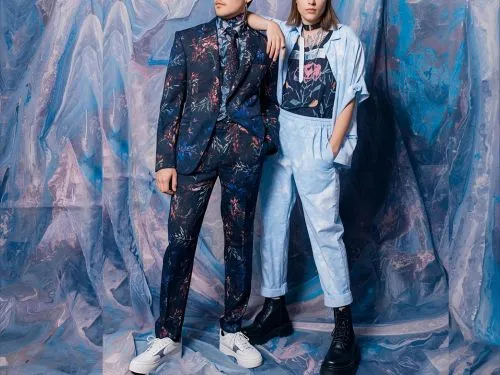As 2026 approaches, the fashion world is set to showcase the best fashion trends, blending creativity with conscience. Designers and brands are prioritising innovation, sustainability, and inclusivity, shaping the future of modern style. Post-pandemic shifts have redefined fashion’s focus, and the coming year promises to build on that evolution. From AI-powered designs and biodegradable fabrics to gender-fluid silhouettes, 2026 will merge technology with timeless craftsmanship. Leading global brands are already presenting collections that highlight the best fashion trends set to define the next era of style.
The Rise of Smart and Sustainable Fashion
One of the most influential shifts in 2026 is the growing intersection between technology and sustainability. Consumers now expect style to align with eco-conscious values, and brands are answering that call with creativity and innovation. Companies like Stella McCartney, Patagonia, and Gucci are leading this charge by using renewable textiles and low-impact production.
Stella McCartney continues to push boundaries with Mylo, a leather alternative made from mycelium, offering a sustainable replacement for traditional animal-based materials. In 2026, her collections are expected to expand on this innovation, making vegan materials luxurious and accessible. Similarly, Patagonia has been investing in regenerative cotton and closed-loop systems, ensuring garments are both durable and recyclable. The brand’s 2026 outdoor line aims to set a new benchmark for ethical outerwear.
Gucci, under creative director Sabato De Sarno, is exploring circular fashion through its Gucci Continuum program, where archival pieces are redesigned into new limited-edition items. This approach gives new life to existing materials while maintaining the brand’s signature luxury appeal. Such initiatives demonstrate how sustainability has evolved from a trend to an essential practice, shaping how luxury and high-street brands alike approach design.
AI and Digital Innovation Redefining Design
Artificial intelligence is revolutionising how fashion is created and consumed. In 2026, AI-generated collections, personalised styling, and virtual fitting rooms are becoming mainstream. Brands such as Tommy Hilfiger and Balenciaga are already embracing this shift.
Tommy Hilfiger’s collaboration with AI platform Reveel allows customers to receive styling suggestions based on their previous purchases and body type. This technology eliminates guesswork and promotes more thoughtful buying decisions. Balenciaga, known for its bold experimentation, continues to merge fashion with digital culture, producing immersive virtual fashion shows and limited-edition digital garments for online avatars.
Meanwhile, Nike has taken innovation to the next level with its .SWOOSH platform, which integrates digital design and user-generated content. By 2026, Nike aims to let users co-create sneaker designs through AI-assisted tools, allowing for a new era of customer-driven creativity. This democratisation of fashion through technology reflects a cultural shift where personalisation and participation are key to brand loyalty.
Minimalism and Quiet Luxury Continue Their Reign
The minimalist trend that gained traction in 2023 shows no signs of fading. In 2026, the idea of “quiet luxury” remains dominant, reflecting consumers’ desire for timeless elegance over fast-changing trends. Brands like The Row, Loro Piana, and Jil Sander exemplify this aesthetic, offering refined craftsmanship and understated silhouettes.
The Row, founded by Mary-Kate and Ashley Olsen, continues to define minimalist chic through structured tailoring, premium fabrics, and neutral colour palettes. Its 2026 pre-fall collection focuses on versatility, featuring transitional pieces that balance comfort and sophistication. Similarly, Loro Piana emphasises craftsmanship through fine cashmere and merino wool, appealing to a clientele that values heritage and subtle opulence.
Even contemporary brands are aligning with this movement. COS, part of the H&M Group, has mastered the balance between affordability and quiet sophistication. Its 2026 collections are expected to feature modular garments designed for mix-and-match styling, reducing wardrobe clutter while promoting long-term use.
Quiet luxury is not about logos or extravagance but about investing in quality and longevity. This mindset reflects a maturing global fashion audience seeking elegance that transcends trends.
Gender-Fluid and Inclusive Fashion
The boundaries between menswear and womenswear continue to dissolve, reflecting society’s growing embrace of diversity and identity expression. Brands like Louis Vuitton, Burberry, and Thom Browne are pioneering gender-neutral fashion lines that celebrate individuality.
Louis Vuitton, under Pharrell Williams, has blurred the lines between masculine and feminine aesthetics, introducing collections that merge sharp tailoring with fluid silhouettes. His 2026 designs are rumoured to continue exploring androgynous luxury, appealing to a younger, progressive audience. Burberry, revitalised under Daniel Lee, is leaning toward functional yet inclusive fashion with unisex outerwear and accessories that adapt to all genders.

At the avant-garde end, Thom Browne challenges traditional dress codes with structured skirts and cropped blazers for men, reinforcing fashion’s new inclusivity. These brands are shaping an industry where self-expression is valued over conformity.
Inclusivity also extends to body diversity. Brands such as Savage X Fenty and Levi’s are setting new standards for representation. Savage X Fenty’s 2025 fashion show received acclaim for featuring models of all sizes, abilities, and genders, and its 2026 line is expected to expand adaptive and extended-size options. Levi’s, meanwhile, continues to offer size-inclusive denim and has introduced customizable fits through its online platform.
Revival of 1990s and Y2K Aesthetics
Fashion’s cyclical nature continues to bring nostalgic trends back to life. In 2026, the 1990s and early 2000s remain dominant influences, but with a refined, modern twist. The playful minimalism of the late 90s meets the tech-inspired boldness of the Y2K era, creating a fusion of sleek silhouettes and futuristic materials.
Prada and Miu Miu are at the forefront of this revival. Prada’s 2026 collection reinterprets classic nylon with sustainable alternatives, creating reimagined cargo pants, cropped tops, and structured outerwear that pay homage to its 90s roots. Miu Miu, under Miuccia Prada, continues to blend youthful rebellion with sophistication, with low-rise skirts, micro cardigans, and ballet flats reappearing in new textures and colourways.
Diesel, led by Glenn Martens, keeps the Y2K aesthetic alive with its bold use of denim and metallic finishes. The brand’s 2026 line expands its “Diesel Library,” a sustainable archive of customizable denim pieces made to last. Even Versace is revisiting its vibrant 90s aesthetic, emphasising vivid prints and gold-accented tailoring, while Balmain continues to modernise power dressing with sleek shoulders and sculptural detailing.
The Return of Craftsmanship and Artisanal Design
While technology and fast innovation dominate much of fashion, there is a parallel movement celebrating craftsmanship and slow fashion. In 2026, consumers are expected to place higher value on artisanal quality and handmade details.
Luxury brands like Hermès and Chanel are leading this movement with collections that emphasise craftsmanship over spectacle. Hermès continues to highlight its heritage through hand-stitched leatherwork, while Chanel’s Métiers d’Art collections celebrate the artisans behind embroidery, lace, and beadwork. These traditions provide depth and authenticity in an industry often criticised for mass production.
Bottega Veneta has also become synonymous with artisanal luxury. Its signature intrecciato weave continues to evolve, with the 2026 collection introducing sculptural handbags and woven outerwear that embody quiet sophistication. Meanwhile, Loewe embraces handcraft in its 2026 line through natural materials and experimental shapes that balance tradition and innovation.
The return to craftsmanship extends beyond luxury. Brands such as Everlane and Sézane are promoting transparency in production and fair trade practices. These labels appeal to modern consumers who want beauty paired with ethics, reflecting a broader cultural demand for authenticity.
Fashion Meets Function: The Rise of Techwear
Functional fashion continues to expand in 2026, merging utility with contemporary design. The growing influence of techwear reflects society’s increasing need for adaptable, weather-resistant, and performance-driven apparel. Labels like Acronym, Nike ACG, and The North Face are setting the tone for this evolution.
Acronym, known for its urban techwear aesthetic, leads the market with high-performance outerwear that combines futuristic design with practicality. Nike ACG (All Conditions Gear) is innovating with lightweight, waterproof fabrics that adapt to extreme environments while remaining stylish. The North Face, in collaboration with Gucci, continues to merge outdoor functionality with luxury fashion. Their ongoing partnership has redefined outdoor wear as both performance gear and a statement of high-end style.
Even luxury brands are incorporating functional details. Moncler’s 2026 “Genius” collaborations include smart jackets with integrated heating and breathable membranes. These advancements represent fashion’s shift toward adaptability, where style meets everyday practicality.
The Growth of Digital Fashion and Virtual Couture
As digital spaces continue to influence culture, virtual fashion is expected to take a central role in 2026. The metaverse and digital clothing markets are growing rapidly, with major fashion houses and tech companies investing heavily in digital couture.
Dolce & Gabbana and Balmain have launched exclusive NFT fashion collections, allowing digital ownership of luxury designs. Ralph Lauren has expanded its digital presence through collaborations with Roblox and Fortnite, providing virtual garments for avatars that mirror real-life collections. This blending of virtual and physical fashion opens new opportunities for brand engagement, particularly among Gen Z consumers.
Virtual fashion also contributes to sustainability by reducing waste from sample production and overstock. As 2026 approaches, expect digital wardrobes and AR try-on tools to become standard features in e-commerce, further transforming how people shop for and interact with fashion.
The Dominance of Personalised and Modular Design
Personalisation continues to define the consumer experience in 2026. Brands are shifting from mass production toward customisation, giving shoppers a sense of individuality and control over their purchases.
Adidas and Nike lead this movement through customizable sneakers available via online platforms. Nike By You allows users to select colours, materials, and finishes, while Adidas Made For You uses 3D scanning to create tailored fits. High-end labels like Burberry and Dior also offer personalisation for accessories and outerwear, ensuring luxury products feel uniquely personal.
The modular design trend also continues to grow. Uniqlo’s LifeWear 2026 line introduces detachable components and convertible garments that adapt to changing weather and lifestyle needs. This practical innovation aligns with sustainability goals while offering style versatility.
The Best Fashion Trends That Shape the Future of Style
Fashion in 2026 represents a harmonious blend of innovation, sustainability, and inclusivity. The industry’s direction shows that creativity can coexist with responsibility, and technology can enhance rather than replace craftsmanship. From quiet luxury and AI-driven personalisation to eco-friendly materials and digital couture, the year ahead promises to be a defining chapter for global fashion.
Brands across all tiers, from Gucci and Hermès to COS and Uniqlo, are proving that the future of style is not just about aesthetics but about purpose and longevity. As consumers continue to value ethics and individuality, 2026 will solidify fashion’s role as both an artistic and cultural force that reflects not only what people wear but also how they choose to live.


